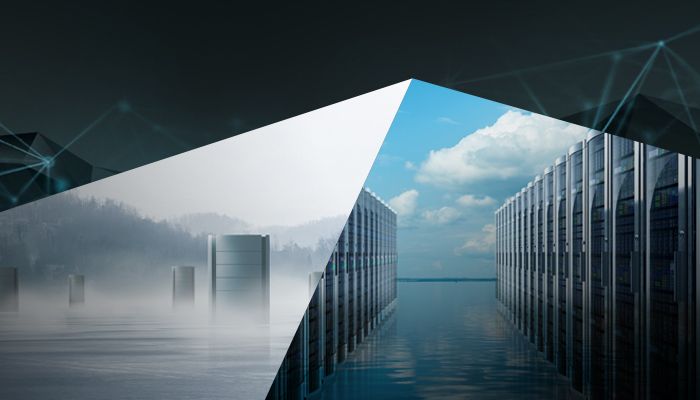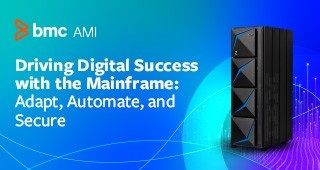In this Run and Reinvent podcast, I chat with Bill Miller, president of BMC’s ZSolutions group, about how customers are reinventing the way they use their mainframe technology and some of the challenges that opens up. Below is a condensed transcript of our conversation.
Allison Cramer: What’s your perspective on what does run and reinvent mean in the context of mainframe?

Bill Miller: In mainframe we’re actually very excited that this is the new BMC tagline, run and reinvent, because it really fits like a glove to our mainframe customer base. We do a survey every year asking for input from our customers and this year the top five issues that the customers had as always in the mainframe space is cost and availability and security. But one of the ones this year was modernization, modernization of the mainframe.
So, run and reinvent fits very nicely into that because we have traditionally helped our customers run their business or their mainframe solutions, but we’re also modernizing our technology so the customers can, working with us, reinvent their solutions so they are better prepared for their end users. They are better prepared for a workplace that is bringing on newer talent to the mainframe space. They are looking for us to develop solutions that are easier to use and that have more automation tied to them so that the workloads stay on the mainframe and even new workloads get attracted to the mainframe because of the ease of use, interest, and automation that is available now.
Allison: You don’t always hear modernization in the same sentence with mainframe. What advice would you give to people who have a big mainframe presence who are trying to make that decision of how they decide? Why would you stay with the mainframe or why would you move off?
Bill: I think that most people that have made a decision to do a hard right and get off the mainframe, it’s taken them a long time to get that done and perhaps they didn’t even get that done because they don’t really think through the advantages of the mainframe. Be it the security, the availability, the scalability, the trustworthiness, etcetera, etcetera, of the mainframe. So, sometimes, they don’t really take into account all of those things when they make the plans and try and execute on getting off the mainframe or taking critical apps off the mainframe.
About 70 percent of the world’s production workloads still run on the mainframe. And it is really only about six percent of the cost of the software and hardware ITs spend. So, it’s really an amazing statistic when you look at it. When you add that to the availability of the mainframe and the flexibility of the mainframe, IBM is now being more proactive in the marketplace, it is still a great place to be. If anything, I expect us to be able to attract more workloads to the mainframe with some of the new things that are going on in the space right now.
Allison: Would you agree with the idea of how modern you are, when you look at assessing yourself, isn’t dictated by the infrastructure choices but more just how you are doing your business? Is that fair?
Bill: Yes. I mean, mainframe might have a connotation that it is old school. Even my kids at times say, “Dad, what do you do? What is this mainframe all about? We never heard about a mainframe.” But there is a lot of coolness to the mainframe. We talk about mainframe being cool here at BMC because we have a lot of young folks that have joined our team that are bringing some of the skills and knowledge that they have of using other technologies that are out there and applying that to the mainframe and allowing us to modernize it and make it easier to use. And to make it such that it is easy to adapt to people that really don’t have the skills that our mainframers that have been around for 30 or 40 years have today.
Allison: You mentioned in the beginning about security and the security advantages that mainframe can provide. Can you talk a little bit about the security challenges and how you all have been addressing those for mainframe?
Bill: That’s a great question, Allison, because most people think the mainframe is totally secure. In reality, that’s not the case. Yes, the mainframe is a very secure platform, but it is not impenetrable. A hacker who knows what they are doing, who knows their way in and out and they work hard enough with skills and talent that they can develop do have the capability to get into a mainframe. That is externally. Then internally, most of the world’s data is still on the mainframe. So, you don’t want people accessing DB2 databases for example that shouldn’t be gaining access to that data, that information on perhaps people’s information. Whether it is social security, address, phone numbers, and things like that.
So, it’s important that our mainframe customers are aware of that and look at some of the technology that is available to make the mainframe very secure. We’ve recently made an acquisition of a company called CorreLog that we’re calling now AMI for Security, Automated Mainframe Intelligence for Security, and it is software that allows our customers to work in a more secure mainframe environment, protecting their data, and able to access the data that moves in and out of the mainframe in a more secure fashion.
Allison: Do you have any examples you could share on how folks are trying to use BMC’s AMI technology?
Bill: what we’re demonstrating to our customers is that our top priority is to develop a self-managing mainframe for our customers. Developing intelligent automation, predictive analysis and things like that so that our customers can focus more on the products they have and use software from folks like BMC to be able to run a more efficient and effective operation in their mainframe shops.
We’ll be delivering four new products this year in the AMI portfolio. One of those is called AMI for DevOps, which is connecting distributed or open systems application code so it can connect more effectively to mainframe develops of DB2 for example. So, they have more of a seamless transition when they work together for applications. We’ll also be delivering some code and new products that will allow us to do a predictive analysis. We call it “seeing around the corner” which means determining a problem for a customer based on using their historical data before the problem even occurs, whether it is a potential slowdown or worse.
We’ll also be delivering some remediation once a problem has been determined. We’ll also be delivering a new product for us that will enable us to do a better job, a more effective job for our customers today of assessing application workloads and their environments as they want to bring on new applications.
One of the coolest things we’re working on is our GUIs and how our products will work and touch and feel with our customers. That is something that we’ll be rolling out this year too, so the customers get a different look and feel from a BMC perspective on how our products appear to our customers.
Allison: There’s lots written anymore on sorting through the noise of your data and trying to figure out what is predictive and what is just noise. How is the tool utilizing that different information and kind of helping people to sort through that and figuring out what could predict and what is just an anomaly?
Bill: We are now working on some modeling that will allow us using some multi variant techniques by looking at all sorts of different angles and looking at customer’s historical data. So, we’re asking customers to give us some historical data from maybe three or six months where in that timeframe they may have had a bump in the night or maybe a slowdown or worse. And we put that into our model using their data and then we go back to customers and show them how our model would have potentially identified that slowdown or worse, a bump in the night, before it even happened. So that, they will be able to tell, as I said earlier, they will be able to look around the corner instead of having something bad happen to them by looking at it.
We have hired a couple of data scientist as well as some architects who are helping us with the modeling and the modeling techniques. We’re now gaining customers who are sharing their data with us so we can make sure the model not only works generically but also will be a model that works in their specific environment based on the fact that we have their historical data. And we’ve shown them that historical data has proven to us and to them that the bump in the night could have been foreseen before it happened.
Allison: I know skills gaps are typically an issue as you don’t maybe have enough people coming into the mainframe space. Do you feel like this will help with that dilemma as well?
Bill: Yes, Allison, I think it will. I mentioned earlier our mainframe survey and the two fastest items that are moving up on the chart of customer concerns from the mainframe survey input were what I mentioned earlier is modernization and security. Aging workforce is another one. When we started the survey 10 or 12 years ago, it wasn’t even on the radar. Now it has become a top five or six issue for customers. It’s not easy at times to get people coming out of university that want to jump into the mainframe because they are not even exposed to it at all. But once we get them in here and they get their hands on the technology that I was just talking about, the multivariant technology for predictive analysis, and things like that, they really get excited about it. They actually bring ideas to our mainframers here that we probably would have never even thought about because of the knowledge they have and the skills they have developed over their years that maybe the folks who have been working here for 30 years don’t even have a sense of what that is or what that experience that might be for them.







